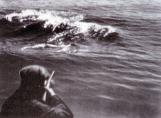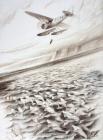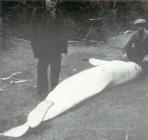1
Aquatic environments have and always will undergo changes that influence flora and fauna. In the late 1920s, after a period of abundance, there was a drastic decline in fish stocks, including cod and salmon. During that same period, St. Lawrence belugas flourished. That was all it took for the small white whales to be blamed for the depletion of commercial fish stocks.The fishermen, who saw their livelihood slipping away, pressured the provincial government. They called for its help, demanding nothing short of the eradication of the beluga from the St. Lawrence. The animal's peaceful days were over.
The Ministère de la Colonisation, des Mines et des Pêcheries distributed rifles and ammunition so that fishermen could shoot all the belugas they saw. Every seaman who brought along his gun when he went out on the water received a monthly allowance of $30. This incentive was soon improved with the addition of a $15 bounty for anyone who brought back a beluga tail to a representative of the relevant department.
According to fishermen, this marine "western" yielded poor results. The government was further pressured to take major action. In this inter-war period, new technologies were developed or made more accessible. Pods of beluga were hunted from the air; a pilot was hired to drop bombs on them from a small plane.
2
Letter addressed to Joseph Lizotte from L. Garnier, a priest at the Rivière-au-Tonnerre mission15 January 1930
Pointe de la Rivière Ouelle, Rivière-Ouelle, Quebec, Canada
 Credits:
Credits:L. Garnier, priest
Émile Lizotte (1902?1988)
3
Man hunting beluga with a gun, possibly for the $15-per-tail premium1928 to 1939
St. Lawrence River estuary, Quebec, Canada
 Credits:
Credits:Vladykov, Vadim-D. "Études sur les mammifères aquatiques." Montreal, Université de Montréal, 1944
Unknown photographer
4
Parliament Building, Legislative Assembly debates, 17th Legislature, 2nd Session4 March 1929
Québec City, Quebec, Canada
 Credits:
Credits:Photograph: Laval Couët
Document: Legislatures, Sessions and Sittings since 1867 (in French)
5
Bombing a pod of belugasEvent of 1929, drawing dated 1996
St. Lawrence River, Lower North Shore, Quebec, Canada
 Credits:
Credits:Frédéric Back
Coloured pencil on white frosted acetate paper
6
Article from Le Soleil, 39th year, Issue 37: "La chasse aux marsouins" [the porpoise hunt]1930
Québec City, Quebec, Canada
 Credits:
Credits:From "Le Soleil"
Unidentified author
7
Fortunately, questions were raised regarding this move to exterminate the beluga. In the late 1930s, Quebec's provincial fisheries department contacted ichthyologist Vadim-D. Vladykov, who had a Ph.D. in biology. The researcher was mandated to study the "white porpoise" and determine if it was in fact responsible for the decreasing commercial fish stocks. This request formed the basis for Vladykov's studies on the hunting, biology and economic value of the "white porpoise" (1944), as well as on the diet of the St. Lawrence "white porpoise" or beluga (1947). Nearly 70 years later, Dr. Vladykov's work is still referenced.In the context of the campaign to exterminate belugas, Vladykov's findings were unsettling. He carefully examined 165 belugas, whose stomachs were found to contain only one salmon and one smelt. He also found two herring and about 20 cod. Belugas were found to feed on mainly capelin, herring, smelt, sand lance, invertebrates and crustaceans.
Although the beluga was eating some fish of commercial value, Dr. Vladykov concluded his research by saying that the damage caused by the "white porpoise" was insignificant and did not in any way influence fluctuations in the fishery over the years. He attributed the fluctuation in fish and beluga populations to variations in water temperature.
Sadly, during this campaign, nearly 3,000 cetaceans were killed. Scientist Vladykov's findings showed that the "white porpoises" were innocent. The bounty system for killing belugas was abolished in 1939.
In the early 1940s, particularly after World War II, beluga by-products became less and less popular. Mineral oils monopolized the market and electrical distribution expanded. In Rivière-Ouelle, Émile Lizotte no longer fished for beluga. Trade decreased and the mammal was no longer around.
The beluga was still hunted by sport fishermen into the 1970s. However, the worrisome population decrease resulted in an official ban on any hunting in 1979. Shortly thereafter, the St. Lawrence beluga population was designated as an endangered population by the Committee on the Status of Endangered Wildlife in Canada (COSEWIC). This status was reviewed in 2004 and the St. Lawrence beluga is now a threatened species. It now benefits from greater protection, but unfortunately, is not safe from chemical and noise pollution, or global warming, which causes various changes to its habitat.
8
Joseph Lizotte and Dr. Vadim-D. Vladikov beside a 3.5-metre-long female beluga25 October 1939
Pointe de la Rivière Ouelle, Rivière-Ouelle, Quebec, Canada
 Credits:
Credits:Vladykov, Vadim-D. "Études sur les mammifères aquatiques." Montreal, Université de Montréal, 1944
Unknown photographer
9
Dr. Vadim-D.Vladykov and Émile Lizotte beside a 3.22-metre-long male beluga3 November 1939
Pointe de la Rivière Ouelle, Rivière-Ouelle, Quebec, Canada
 Credits:
Credits:Vladykov, Vadim-D. "Études sur les mammifères aquatiques." Montreal, Université de Montréal, 1944
Unknown photographer